Oddly enough, there are some places you simply can’t drive through without stopping. Teslin, Yukon is one such place. I wasn’t sure if it was the call of the Tlingit culture, the hint of determination in a small highway town, or the draw of the lake, but something was waiting to pull us in.
Disclosure: This post contains Affiliate links.
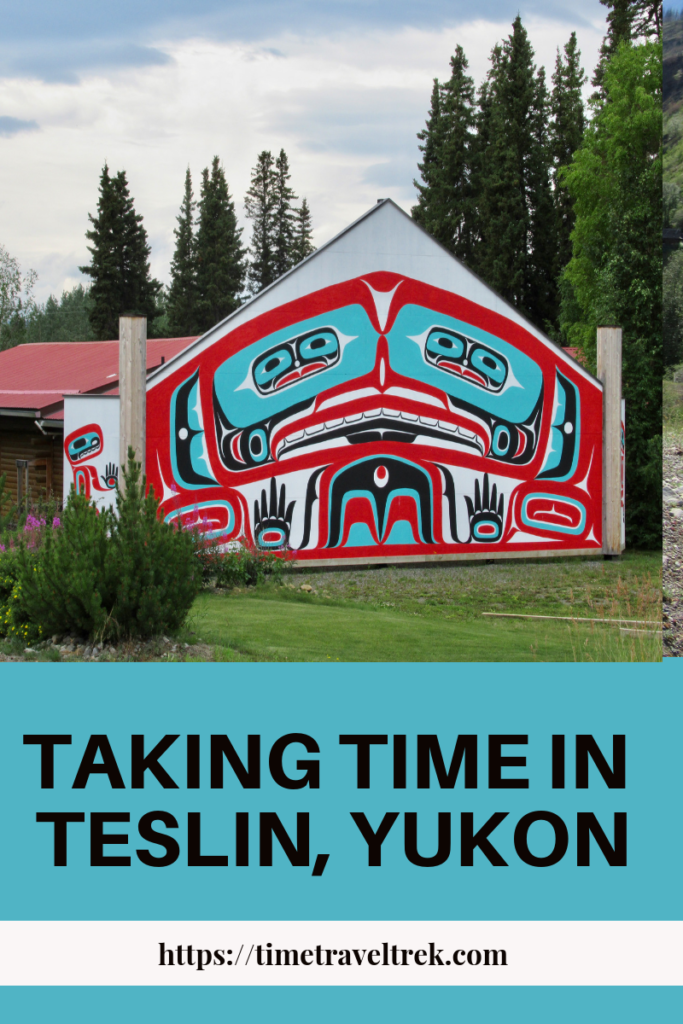
Table of Contents
The First People of Teslin, Yukon
Teslin is the traditional homeland of Inland Tlingit. In the 19thcentury, small groups of Coastal Tlingit migrated from what is now Southeast Alaska. They followed the Taku River to Atlin, British Columbia and then headed overland. A few settled in Atlin, others in Carcross and the rest in and around Teslin. Teslin is derived from a Tlingit word meaning “long, narrow water.” The lake is 125 kilometres (75 miles) long.
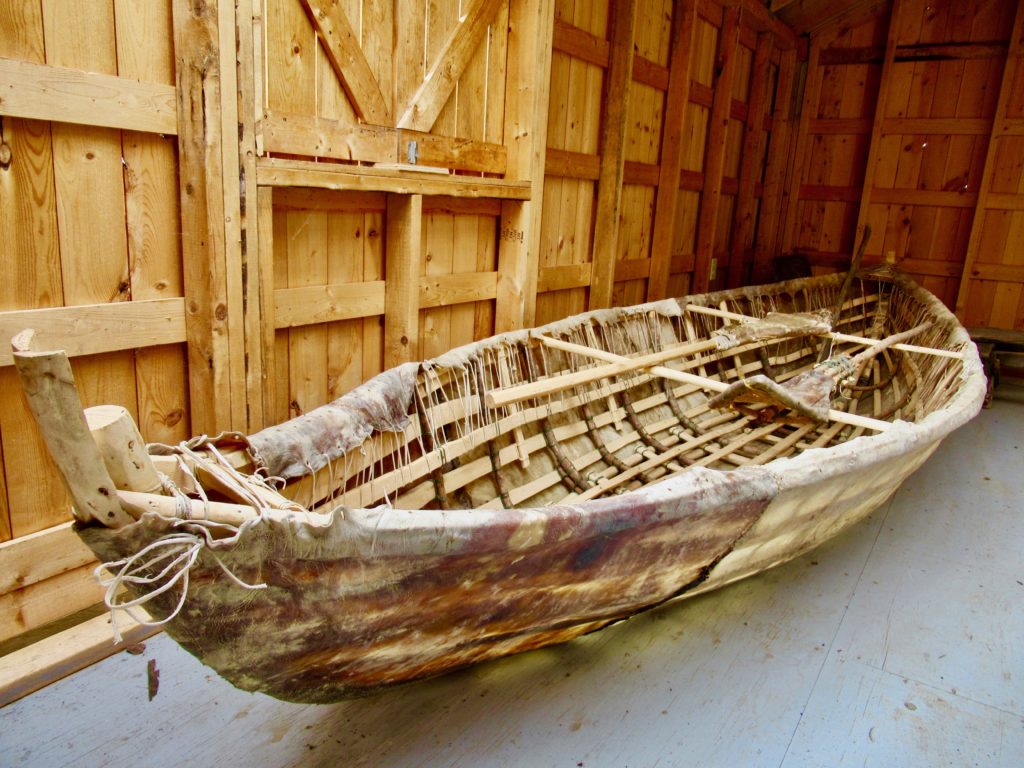
(Photo: Megan Kopp)
In early years, travel was done on foot, by birchbark or dugout canoes, moose hide boats, or on snowshoes.
Be sure to check out our posts on canoeing the nearby Nisutlin River nearby and visiting the Yukon Wildlife Preserve in Whitehorse!
Tlingit families moved seasonally for hunting, fishing and gathering of food. In the late 1800s, they began to travel to trading posts. Animal furs became a valuable commodity. Winters were spent on traplines. Furs were traded for food, rifles, ammunition, tobacco and sewing materials.
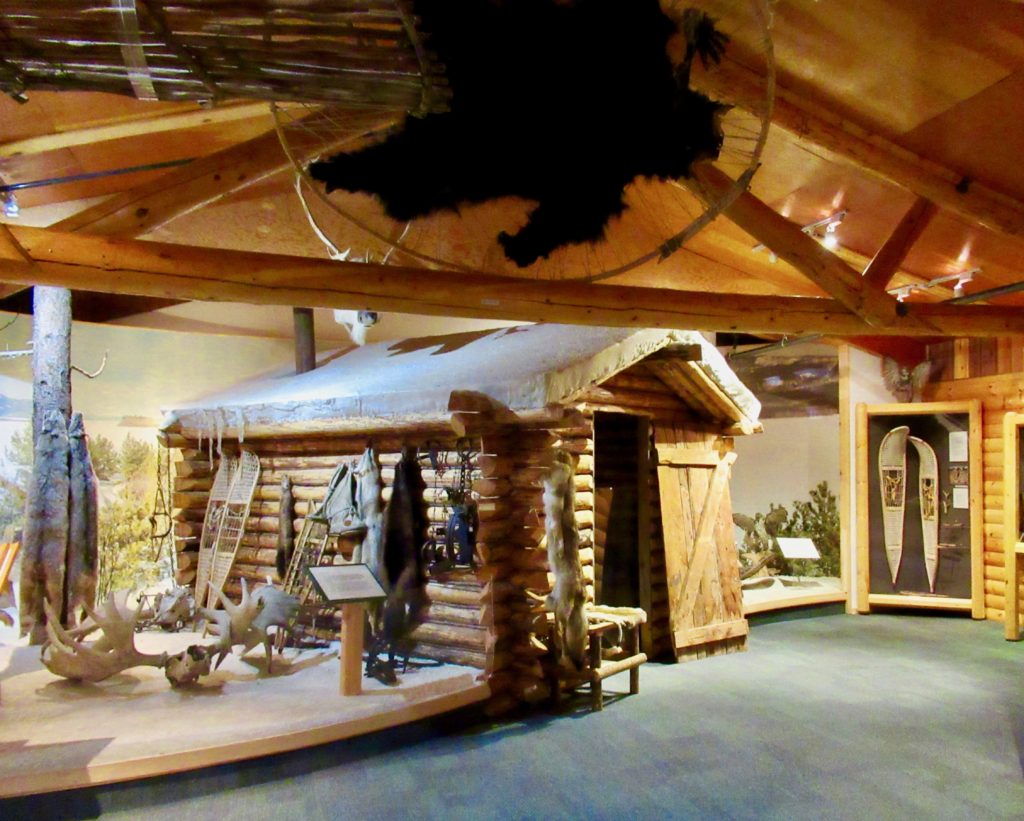
Time for a Teslin Trading Post
A trading post was set up on the shores of the lake by the Hudson’s Bay Company in 1897. It closed four years later. Taylor and Drury, Co. were based in Whitehorse. They also had up to 15 satellite trading posts around the Yukon. One opened in Teslin a few years after the HBC post closed. Twice a year, T & D had goods shipped in by steamboat from Whitehorse. In the 1930s, former RCMP officer, Robert McCleery ran a post in Nisultin Bay and famed Tlingit resident George Johnston started trading as well.
A Man and His Car
It’s pretty near impossible to stop in Teslin and not hear or read something about George Johnston. George was a forward-thinking individual quick to embrace the parts of European culture that suited his needs. He bought a camera and started photographing Tlingit people at work and play, capturing a rapidly changing way of life. In 1928, he bought a Chevrolet car in Whitehorse, learned to drive on the airstrip and then had it shipped by paddlewheeler to Teslin.
It didn’t matter that there were no roads. He paid for help to build one – a full five kilometres (3 miles) from Teslin to fish camp. He sold rides to local villagers. In winter, he painted the car white so that it was camouflaged when he drove across the ice-bound lake for hunting. He also used it as an ice-fishing shack. You can see his pride and joy today in the museum bearing his name.
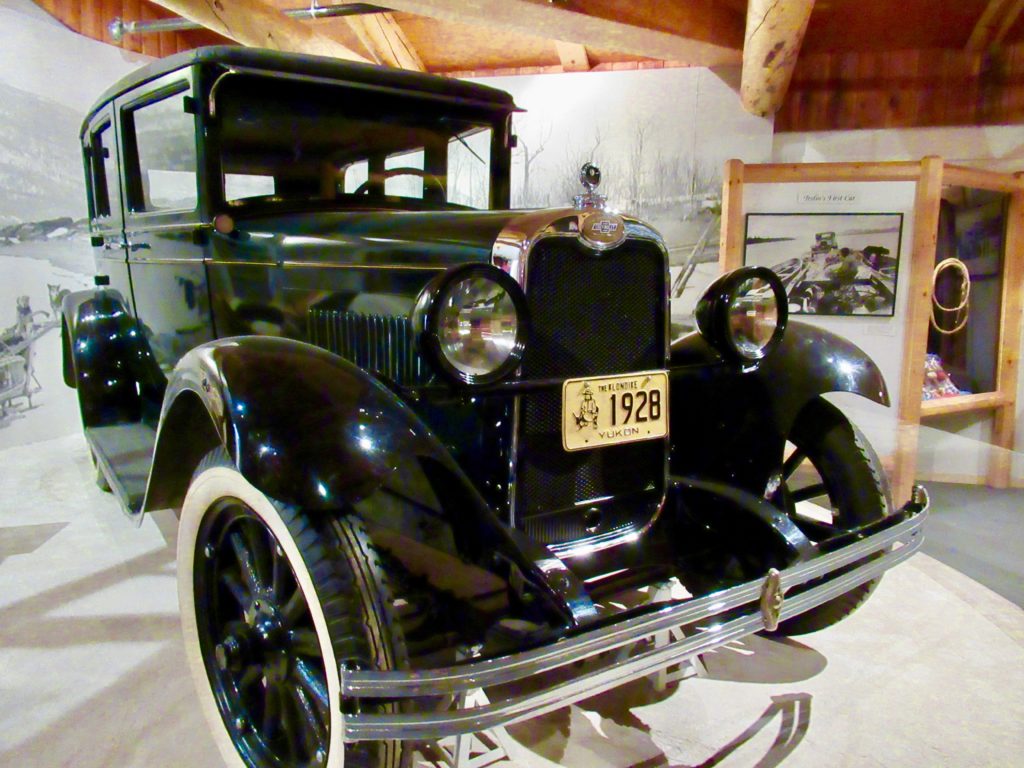
A Rocky Road
The museum not only tells George’s story and shows off his 1928 Chevrolet, it highlights the Tlingit people and their adaptation to change. During World War II, the Canadian Government began building a line of air navigation stations in the north. Teslin was one of the range stations. The restored radio repeater station sits beside the George Johnston Museum, together but separate.
This was the same for the community as Tlingit people saw an influx of outsiders with the building of the Alaska Highway. In 1942, the area was declared an American military zone. Teslin Tlingit were treated as aliens in their homeland. It would take over 50 years of trials and tribulations, but stability slowly returned. In 1994, the Teslin Tlingit Land Claim Agreement was signed by the Canadian Government.
Teslin, Yukon and the Tlingit Heritage Centre
Just down the road a few kilometres from the George Johnston Museum is the Teslin Tlingit Heritage Centre. Five colourful totem poles representing the five Tlingit clans lead up to the award-winning building designed by Yukon architects. The poles represent the Eagle (Dakhł΄awèdi), Beaver (Dèshitàn), Wolf (Yanyèdi), Frog (Ishkìtàn), and Raven Children (Kùkhhittàn) clans.
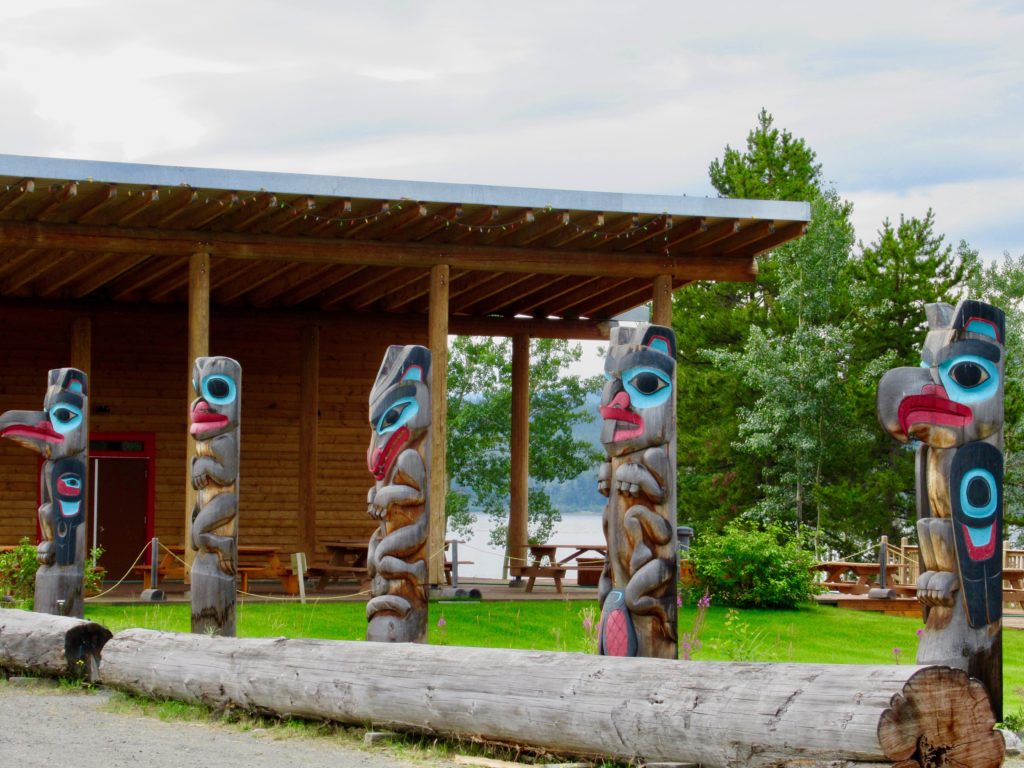
Our eyes are drawn from the poles down the path leading to the lake, where a colourful replica canoe sat on the shore. In front of the boat, are a ramshackle collection of small buildings. This is fish camp. Outside one of the canvas-covered buildings, a man is working a piece of cedar. The artist is Keni Johnston. George is his great uncle.
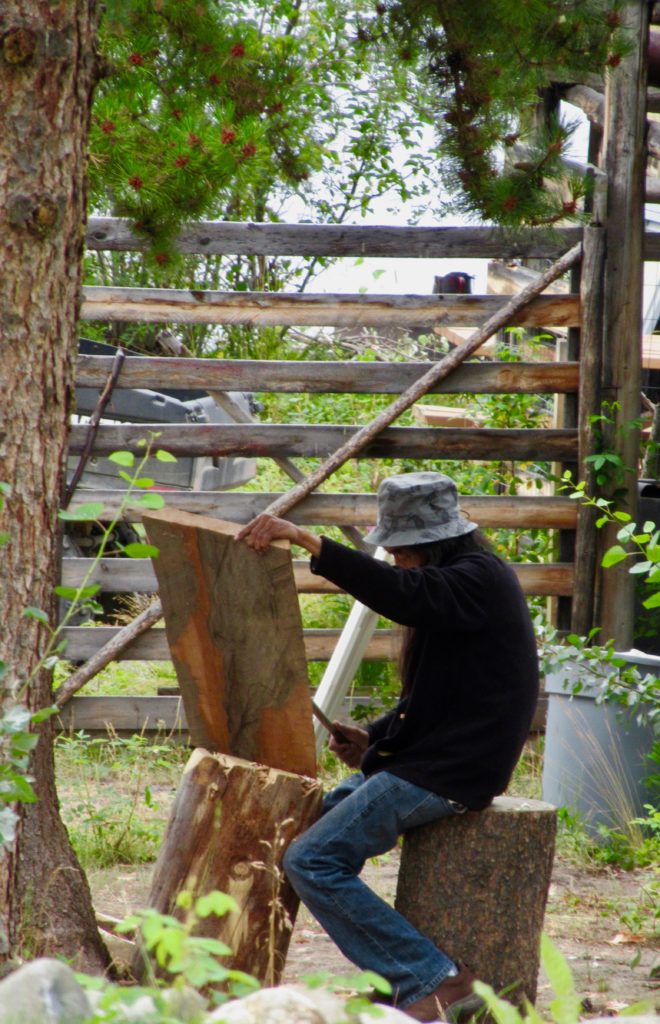
With an easy smile, Keni explains about the replica of a copper chestplate he is carving out of wood. He likes to work with old growth wood. It is something that will soon be gone and our children’s children may never see it. In art, it lives on forever.
A Place of Meeting and Learning
Stepping in the Heritage Centre, we see the small museum display helping visitors learn more about the Tlingit culture. A wall tent is set up in the middle of the large open space. Looking out the tall windows, endless views of the lake and the distinctive Lone Sheep Mountain (Tle’nax T’Awei), also known as The Three Aces or Dawson Peaks.
Back inside, beside the wall tent, an older man is sitting at a table working on a word search. In front of him are a stack of three thick books, all relating to Teslin Tlingit language. Behind him on the wall are five button blankets. Three show the clan totems. Two are completely black.
“Can I ask you a question,” I address the man behind the table.
He looks up and nods.
“Why are two of those wall hangings turned away?”
“For the same reason that flags are hung at half mast, there was a loss in the clan,” he answers quietly.
A moment of quiet.
Looking at the books, I ask if the Teslin Tlingit language differ much from the Coastal Alaskan Tlingit language.
“Come closer,” he says, “I can’t hear very well.”
I move around next to his chair, hip perched on the edge of the table, and enter the wonderful world that is 84-year-old Sam Johnston.

Anyàłashash
Sam Johnston’s Tlingit name is Anyàłashash. Keeping the Tlingit language alive is very important to him. We talk about the changes in language between the Tlingit cultures. I learn that Sam is George’s nephew and Keni’s Uncle. We discuss the importance of heritage.
Conversation switches to politics and I discover that Sam is the Frog (Ishkìtàn) Clan Leader. He was chief of the Teslin Tlingit for many years. Sam was also the first aboriginal speaker of the Yukon Legislative Assembly from 1989-1992.
It’s time for me leave as my guy has been patiently waiting in the wings.
“Stay, let’s talk a little longer,” Sam says.
I do.
Sam is actively involved with the youth in his community. He does his best to impress the value of connecting with one’s culture but also getting as much education as possible. Sam also values travel.
“I’ve been across Canada and the United States. I like Europe, especially Germany,” Sam says with a smile.
It could have been the call of the Tlingit culture, the hint of determination in a small highway town, or the draw of the lake, but I’m thinking it just might have been the spirit of a fellow traveller that was waiting to pull us in to Teslin, Yukon.
Read more of our cultural discoveries in Canada’s North at:
- Historic Telegraph Creek
- Exploring Northern BC: Kispiox, Kitwanaga, and Kitwancool
- Exploring Northern BC: K’san Historical Village
- Exploring Tombstone Territorial Park, Yukon Canada
- Hiking in Tombstone Territorial Park, Yukon Canada
- Yukon Adventures: Finding Stories Tall & True
- Exploring Carcross, Yukon
Additional Resources:



Unbelievable what internet searching can reveal!!!
My grandfather was Robert (Robin) Mc Cleery, and his wife was Suzan (Suzi)(nee Taylor).
I have often wondered how the met. Could she have been a daughter of the Taylor of Taylor & Drury, Co.? They were married in Atlin.
My mother, Joyce, was one of their daughters and married my father, Harold ‘Erl’ Erlandson in Teslin. He was in the RCAF. Could he have had something to do with the air navigation station in Teslin? One of Mum’s friends was Lillyanne (sp?) who, when we lived in Ottawa used to send us wild cranberries and, one time, some bear meat (not my favourite!). Was Lillyanne a Johnston or related?
I was born in Whitehorse (August, 1949) and spent my first 3 or 4 years in Teslin. Why didn’t I quiz my mother and grandmother about our history?
I have a very old photo album of my grandmother’s but have no idea of where the pictures were taken or who the people were in them. I was also left some official documents of my grandfather’s after he retired from the RCMP. I’m not sure if any or all of this memorabilia would be of interest to the Teslin museums. I feel that this is where it belongs. I would be very happy to send photos of what I have if they would like to contact me.
If anyone else could help to fill in any gaps of my grandparents’, parents’ or even my history, I would be very pleased to hear from them.
What an amazing story Beverley-Anne, so happy that you stumbled across my post and were able to make these connections! I’m sure the George Johnston Museum would love to receive the photos. They may also be able to help you identify people in the photos and help fill in the gaps in your family’s story. I would suggest contacting them directly through their website, http://gjmuseum.com. Please let me know how it goes, I always love hearing about connections to the past!